There is an ambitious project of urban renewal in Marseille, named Euroméditérranée. The same name is given to the city-planning agency that elaborates and manages the project. The project began its development in 1988 but it did not grow until 1995. A city-planning agency is a specific body depending on the central French administration acting on a specific territory, in a project that is defined as being of “national interest” and aiming to coordinate public investments and to attract the private ones. In Marseille the project span 320 hectares in three sectors: Saint Charles station and its environment (TGV arrival to the train station and intermodal enlargement with buses. Belle de Mai quarter (with the big tobacco factory). La Joliette inner harbour and waterfront (with several projects of port restructuring and urban improvement).
Euroméditérranée interventions have been important since the second half of the decade of 90s of past century but they had small impact and presence in the city. They were done in a broad area and they had very different objectives until the present year. With the nomination of Marseille as the European Capital of Culture 2013 the project received a big boost, specially the interventions on the waterfront with a very slow evolution and without an image of renewal until that moment. In 2013 several interventions have been finished namely in the J4 dock and the Fort Saint Jean with a critical mass that makes possible for the renovation to attract a high number of visitors. That is happening at the moment in the public spaces and the open cultural buildings. Some works have to be finished to obtain the final continuity and connection of the full project.
All these proposals are very important from several points of view: urban planning, architecture, socio-economic impact and management. So they will be analysed in a more profound detail in further issues of PORTUS. A study comparing the port renewal projects of the four main cities of the Occidental Mediterranean (Barcelona, Genova, Marseille, València) will be done. These projects show important differences in the models of interventions, the objectives and the management and this deserves a profound analysis. The present short note is only a summary of the situation and main characteristics of the most relevant projects of port revitalization in Marseille at November 2013:
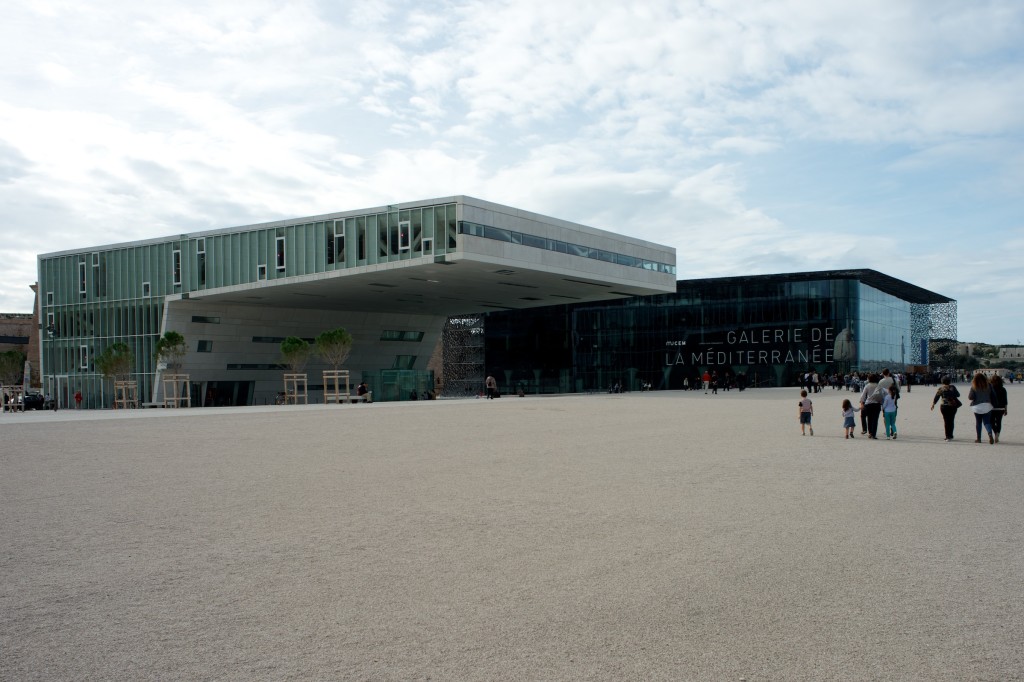 Villa Méditerranée and MuCEM. (© Joan Alemany, 2013)
Villa Méditerranée and MuCEM. (© Joan Alemany, 2013)
-
J4 dock area: It is at present, the most important and visited project. It includes: remodelling and construction of several buildings in Fort Saint Jean; construction of the Musée des Civilisations de l’Europe et de la Méditérranée (MuCEM), this project of Rudy Ricciotti is the most ambitious one both from the architectural and cultural points of view and is the main vector of attraction of visitors to the area; Villa Meditérranéea cultural centre for temporary exhibitions, project of Stefano Boeri.
-
In the further zone of the port area subjected to revitalization there is the CMA-CGM Tower belonging to the main French shipping company and one of the most important in the world, with a project of Zaha Hadid.
 MuCEM and the footbridge. (© Joan Alemany, 2013)
MuCEM and the footbridge. (© Joan Alemany, 2013)
 Dock of the MuCEM. (© Joan Alemany, 2013)
Dock of the MuCEM. (© Joan Alemany, 2013)
-
Between these two zones there are:
-
Silo Arenc, dedicated to include offices and a show hall in a neighbourhood of new offices and apartments.
-
The Docks, extraordinary port warehouse with a length of 365 meters and six floors, planned and built in 1858 by the civil engineers (Ingènieurs de Ponts et Chaussées) Hilarion Pascal and Gustave Desplaces, recently renovated with a project of Éric Castaldi. It has an important socioeconomic impact in the zone. Near the end that opens to the Joliette square it hosts 220 small enterprises and near 3000 employments.
-
Shopping center Les Terrasses du Port, this big shopping centre is at this moment in construction in front of the Grand Dock, and it is expected to open spring 2014.
-
Port warehouse J1, an exhibitions hall, that hosts at this moment an interesting exhibition about Le Corbusier.
-
The cathedral Major esplanade, and the construction below it of shopping centres.
-
The Regards de Provence Foundation, small museum and halls.
-
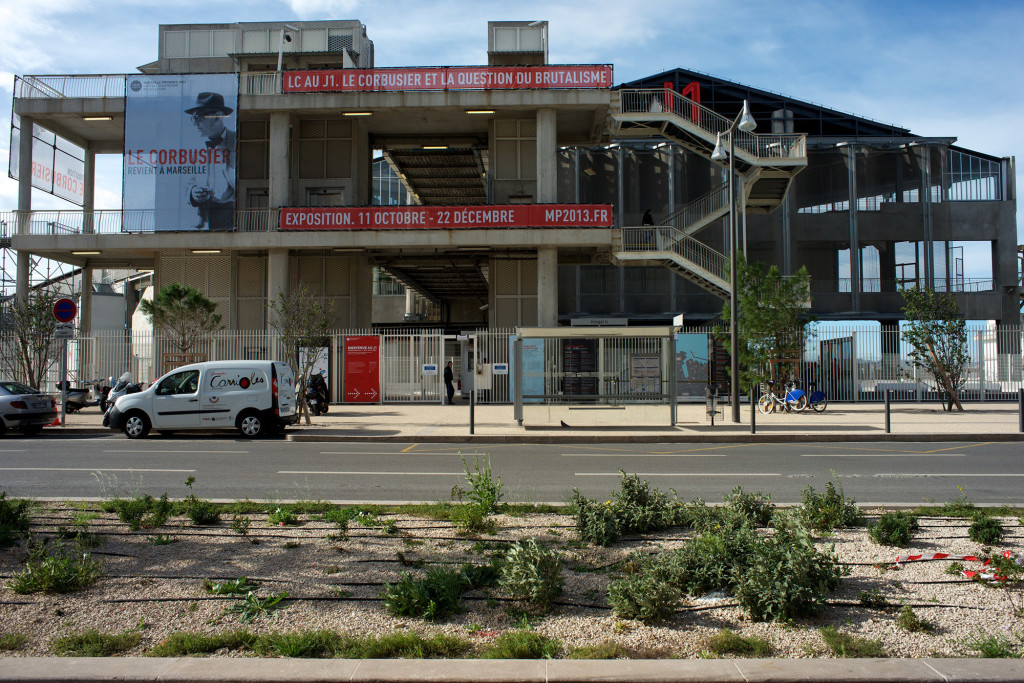 J1 warehouse. (© Joan Alemany, 2013)
J1 warehouse. (© Joan Alemany, 2013)
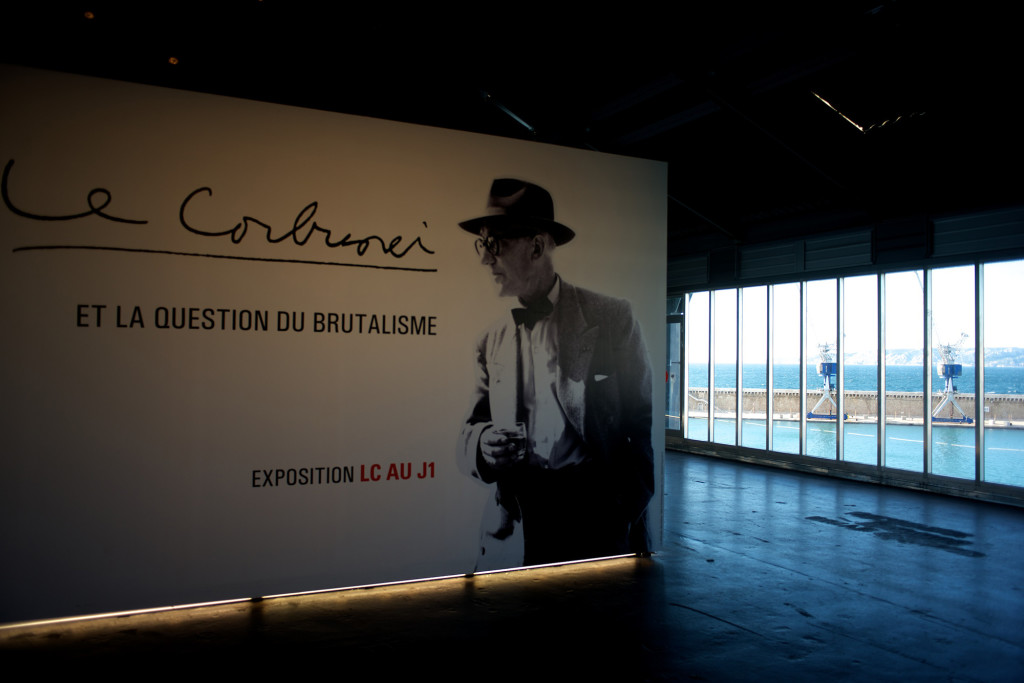 Interior of the J1. (© Joan Alemany, 2013)
Interior of the J1. (© Joan Alemany, 2013)
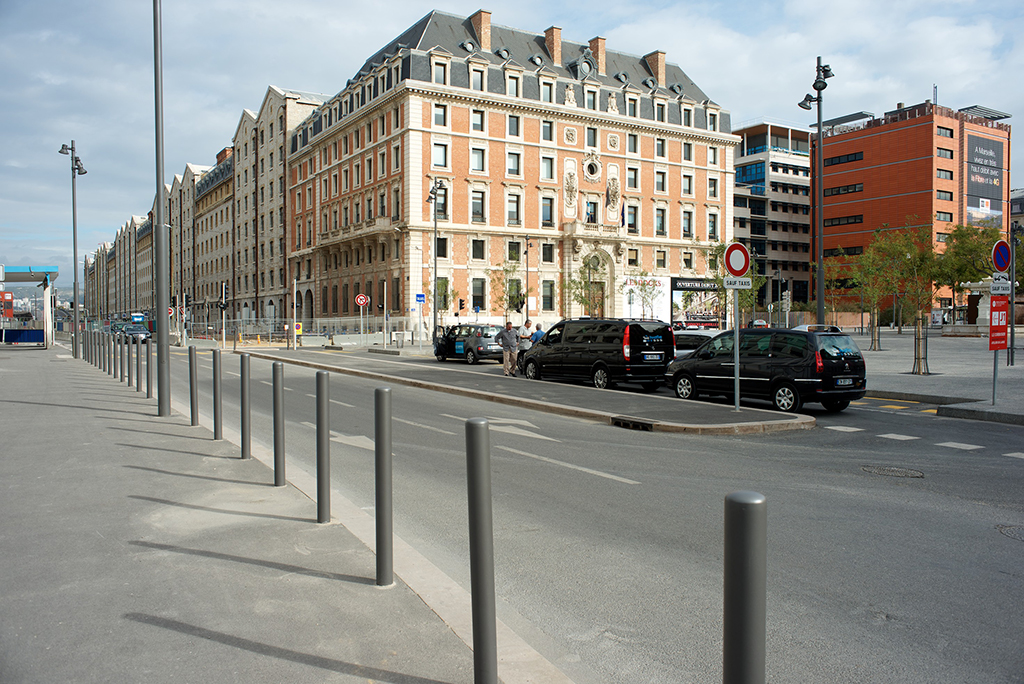 The Docks. (© Joan Alemany, 2013)
The Docks. (© Joan Alemany, 2013)
To carry out this ambitious project of renewal and revitalization of the port area another important intervention has been needed in terms of traffic infrastructures. The highway that separated the city from the port has been removed, the direction of traffic has been reorganized and two interesting footbridges have been built between the Fort Saint Jean and Le Panier and between Fort Saint Jean and the terrace of the MuCEM. It is too soon to know if the reorganization of traffic directions will be enough to promote the direct relationship, the global connection and the dialogue between the urban areas and the new buildings, that are the aim of the Euroméditérranée project or if the traditional physical and functional separation between the city front and the port area will continue to exist. In fact, the extended area dedicated to the ferry traffic with the North of Africa, closed because security rules with a double barrier, is, without doubt, a discontinuity zone that introduces a difficulty to the relation between all the projects. The footbridges for pedestrians are very positive tools to help the connection between the different city areas and the port and to facilitate the access of the citizens.
 Road infrastructures in La Joliette. (© Joan Alemany, 2013)
Road infrastructures in La Joliette. (© Joan Alemany, 2013)
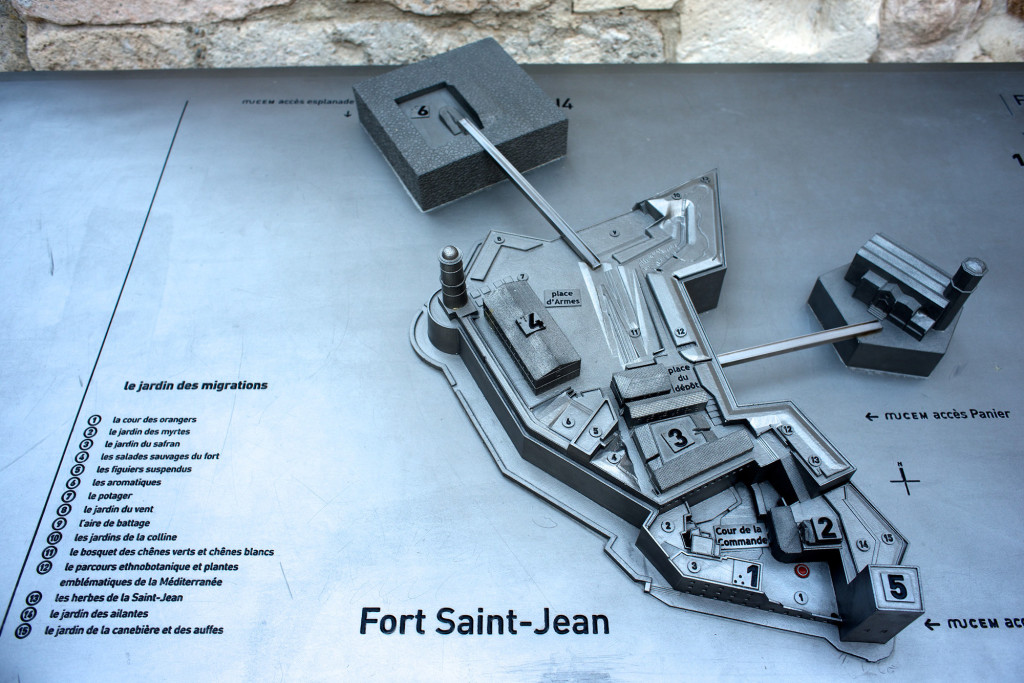 Explanatory model of the Fort Saint Jean. (© Joan Alemany, 2013)
Explanatory model of the Fort Saint Jean. (© Joan Alemany, 2013)
It is noteworthy to say that all these interventions just explained, come together with other projects that are being developed in the neighbourhood and that will have also a great importance. Some very relevant ones are: the restoration of the Rue de la République with traffic restrictions, a new tram and the renewal of shops; the improvement of the docks of the Vieux Port and the new cover of the Quai de la Fraternité; and the renovation of the Museum of History of Marseille.
 Rue de la République. (© Joan Alemany, 2013)
Rue de la République. (© Joan Alemany, 2013)
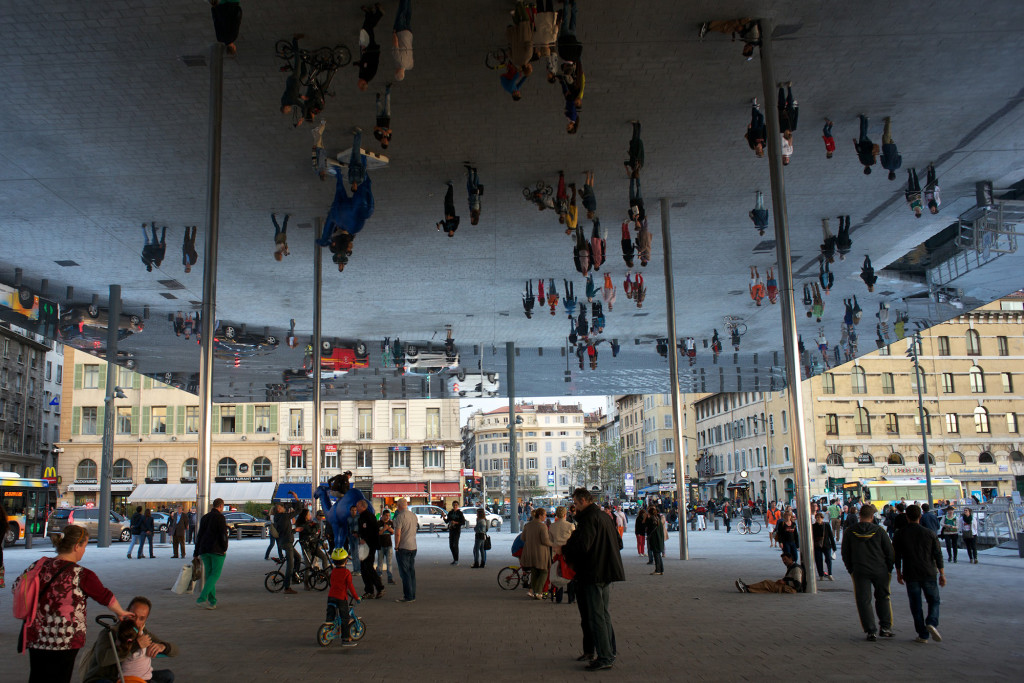 Amusing cover of the Quai de la Fraternité. (© Joan Alemany, 2013)
Amusing cover of the Quai de la Fraternité. (© Joan Alemany, 2013)
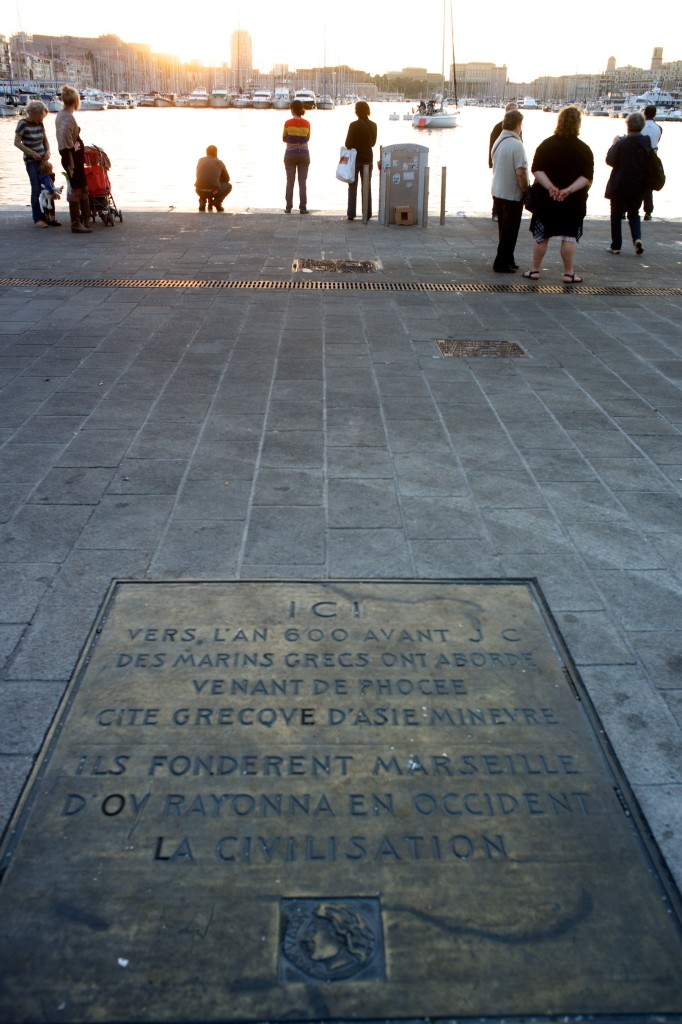
Place in Vieux Port. (© Joan Alemany, 2013)
Head Image: Dock of MuCEM. (© Joan Alemany, 2013
Marsella, el puerto y la Capital Europea de la Cultura 2013
Con el nombre de Euroméditerranéese denomina a la vez el ambicioso proyecto de renovación urbana para Marsella y la agencia de urbanismo que lo elabora y lo gestiona en la práctica. El proyecto se empieza a gestar en 1988, pero no recibe un importante impulso hasta 1995. La agencia de urbanismo es una figura específica dependiente de la administración central francesa que actúa sobre un determinado territorio, con un proyecto que es calificado de “operación de interés nacional” para coordinar las inversiones públicas y atraer las privadas. En el caso de Marsella el proyecto de actuación abarca unas 320 Hectáreas en tres grandes sectores: la estación Saint Charles y su entorno (llegada del TGV a la de ferrocarril y ampliación intermodal con autobuses), el barrio Belle de Mai (con la gran fábrica de tabacos), la fachada marítima y dársena de La Joliette(con diversos proyectos de reconversión portuaria y mejora urbana).
Las actuaciones de Euroméditerranée han sido importantes desde la segunda mitad de los años noventa del siglo pasado, pero han tenido relativamente poco impacto y presencia en la ciudad, dada su dispersión en una amplia área y a la disparidad de objetivos, hasta el presente año. Con motivo de la declaración de Marsella como capital europea de la cultura 2013 se ha dado un impulso importante al proyecto y, especialmente a las actuaciones sobre la fachada marítima, que hasta ahora había evolucionado muy lentamente y carecido de una imagen potente de renovación. En 2013 se han terminado unos proyectos, especialmente en el muelle J4 y el Fort Saint Jean, que tienen la masa crítica para que la reconversión y revitalización tenga capacidad de atracción para una gran cantidad de visitantes. Así sucede actualmente con los espacios públicos y los equipamientos culturales abiertos, pero falta terminar todavía algunas importantes obras en la zona portuaria que acabarán dando continuidad y cohesión al conjunto del proyecto.
Todas estas propuestas merecen por su importancia urbanística, por sus arquitecturas, por sus impactos socio-económicos y por su gestión unos análisis más profundos y detallados en los próximos números de PORTUS. Pronto deberán estudiarse también comparativamente las reconversiones portuarias que, con muy distintos modelos de intervención, de objetivos y de gestión han abordado las cuatro principales ciudades y puertos del Mediterráneo Occidental: Barcelona, Génova, Marsella, Valencia. En esta breve nota solo se describen muy resumidamente la situación y características de los principales proyectos de recualificación portuaria de Marsella actualmente (Noviembre 2013):Villa Méditerranée y MuCEM. (© Joan Alemany, 2013)
- Área del muelle J4:Actualmente es la más importante y visitada. Comprende: remodelación y construcción de nuevos edificios del Fort Saint Jean; construcción del Musée des Civilisations de l’Europe et de la Méditerranée (MuCEM), el proyecto de Rudy Ricciotti es el más ambicioso tanto desde el punto de vista arquitectónico como cultural y es el principal vector de atracción de visitantes al área; Villa Méditerranée, el centro cultural para exposiciones temporales con proyecto de Stefano Boeri.
- En el extremo opuesto del área portuaria en revitalización se encuentra la Torre CMA-CGM, de la principal compañía naviera francesa y una de las más importantes del mundo, con proyecto de Zaha Hadid.
MuCEUM y pasarela peatonal. (© Joan Alemany, 2013) Muelle del MuCEM. (© Joan Alemany, 2013)
- Entre estos dos extremos de esta zona portuaria se en encuentran:
- Silo Arenc, instalación dedicada a oficinas y sala de espectáculos y con un área en su entorno urbano más próximo de nuevas oficinas y apartamentos;
- Les Docks, extraordinario almacén portuario de 365 metros de longitud y seis pisos de altura, proyectado y construido en 1858 por los ingenieros civiles ( Ingènieurs de Ponts et Chaussés) Hilarion Pascal y Gustave Desplaces, rehabilitado recientemente con proyecto de Éric Castaldi y con notable impacto socio-económico en la zona (junto a su cabecera que da a la Place de La Joliette acoge a 220 pequeñas empresas y cerca de 3000 empleos);
- el gran centro comercial Les Terrasses du Port,actualmente en construcción delante de Les Docks que tiene prevista su inauguración en la primavera de 2014;
- el almacén portuario J1 preparado como Sala de Exposiciones con actualmente una interesante muestra dedicada a Le Corbusier;
- la explanada de la catedral La Majory la construcción en su base de unas galerías comerciales;
- el pequeño museo y salas de la Fundación Regards de Provence.
Almacén J1. (© Joan Alemany, 2013) Interior del J1. (© Joan Alemany, 2013) Les Docks. (© Joan Alemany, 2013)
Para la realización de este ambicioso proyecto de renovación y revitalización urbano-portuaria ha sido necesaria la realización de un complejo proyecto de cambio infraestructural de las vías de circulación rodada, con la supresión de la autovía urbana elevada que separaba irremediablemente el puerto y el área urbana, la reorganización del tráfico rodado y la muy interesante construcción de las pasarelas elevadas peatonales entre el barrio de Le Panier y el Fort Saint Jean y entre éste y la terraza del MuCEM. Todavía es pronto para decir si la reorganización del tráfico rodado permitirá la relación directa, la conexión global, el diálogo de áreas urbanas y nuevos equipamientos que pretende el proyecto Euroméditerranée o, por el contrario entre la fachada urbana y el espacio portuario remodelado continuará la separación física y funcional tradicional. La extensa área dedicada al tráfico de los ferrys con el norte de África, cerrada por razones de seguridad con una doble barrera es, sin duda, una zona de discontinuidad que dificulta la relación de los distintos proyectos. En cualquier caso la remodelación de las vías de tráfico y la construcción de las dos pasarelas para peatones son dos elementos muy positivos que contribuyen a conectar mejor las diferentes áreas de la ciudad y el puerto y a facilitar el acceso de los ciudadanos.Infraestructuras viales en La Joliette. (© Joan Alemany, 2013) Maqueta explicativa del Fort Saint Jean. (© Joan Alemany, 2013)
Por último, también es necesario apuntar que las propuestas de rehabilitación y mejora de las áreas e instalaciones descritas anteriormente están acompañadas por otras propuestas que se desarrollan en su entorno y son también muy importantes. Entre ellas cabe destacar: la restauración de la Rue de la République, con las restricciones de tráfico, su nuevo tranvía y la renovación del equipamiento comercial; la mejora urbana de los muelles del Vieux Port y la nueva cubierta del muelle de la Fraternité; la renovación del Museo de Historia de Marsella.Rue de la République. (© Joan Alemany, 2013) Divertida cubierta del Quai de la Fraternité. (© Joan Alemany, 2013) Placa en el Vieux Port. (© Joan Alemany, 2013)
Head Image: Muelle del MuCEM. (© Joan Alemany, 2013)